最新高中英语高考二轮复习专题 语法词类和句子成分(17张ppt)
文档属性
| 名称 | 最新高中英语高考二轮复习专题 语法词类和句子成分(17张ppt) | 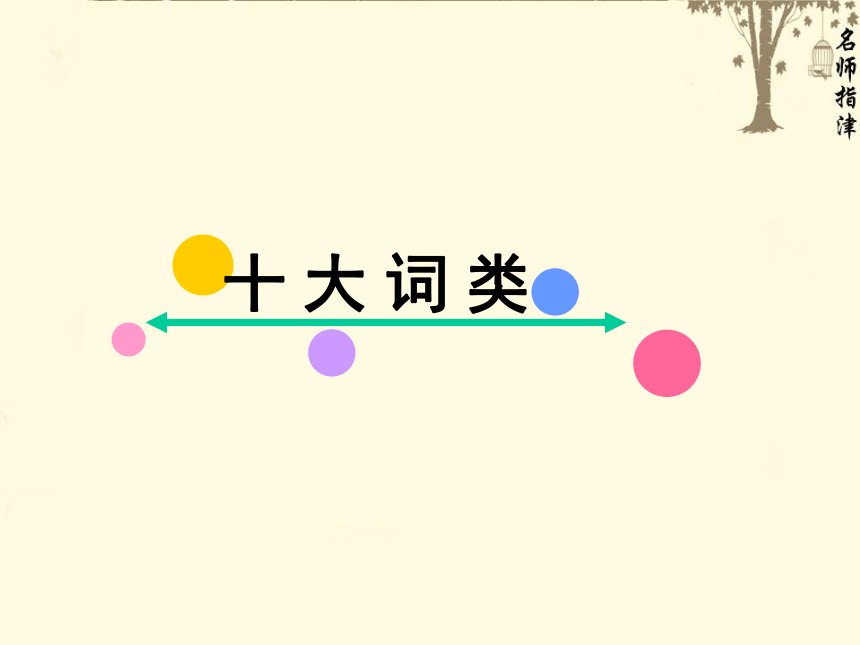 | |
| 格式 | zip | ||
| 文件大小 | 620.0KB | ||
| 资源类型 | 教案 | ||
| 版本资源 | 通用版 | ||
| 科目 | 英语 | ||
| 更新时间 | 2021-03-31 13:16:05 | ||
图片预览


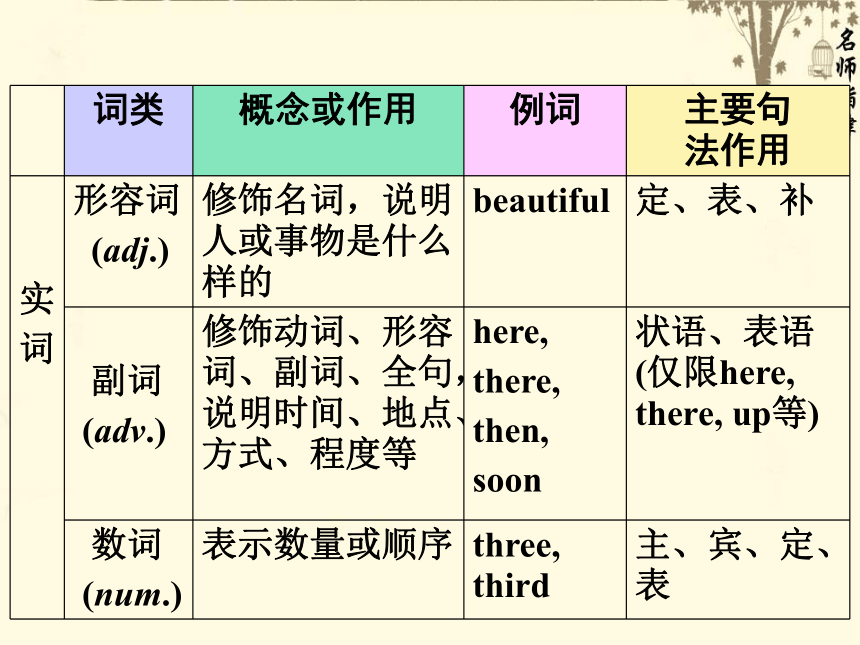
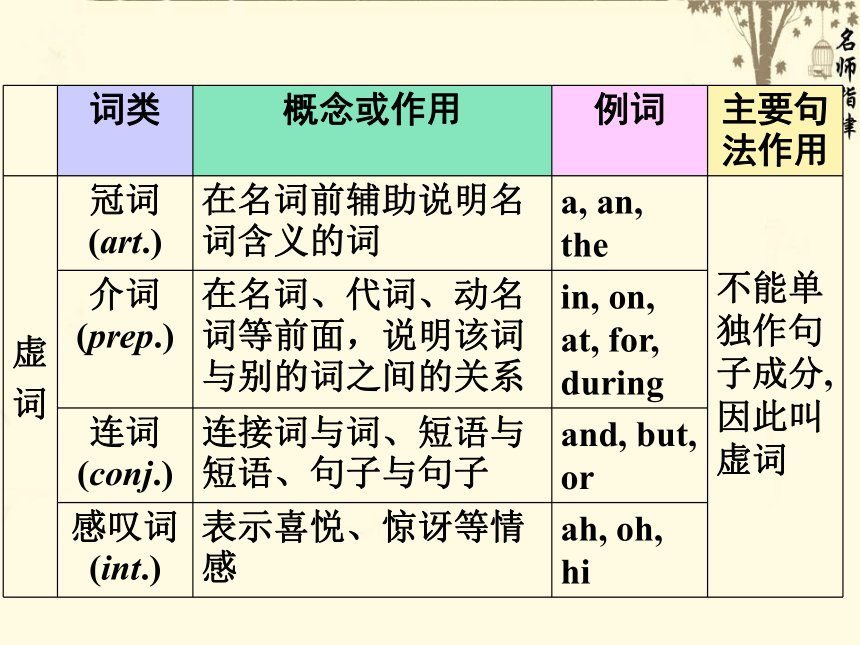
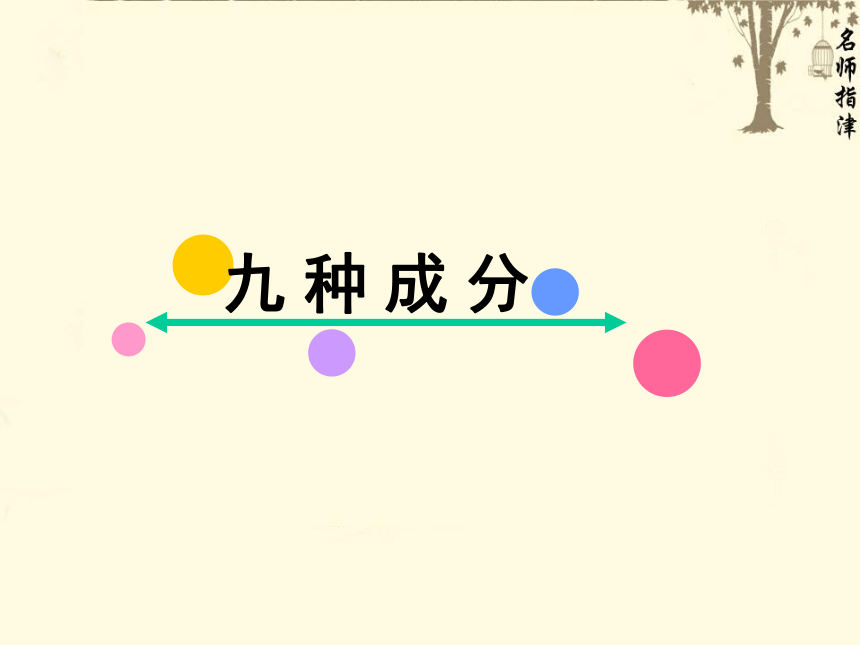
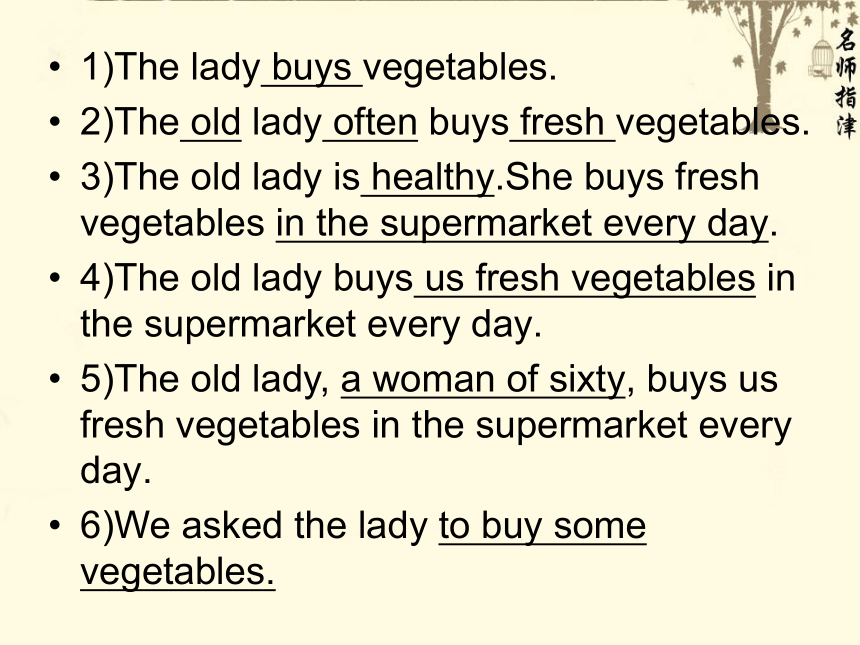
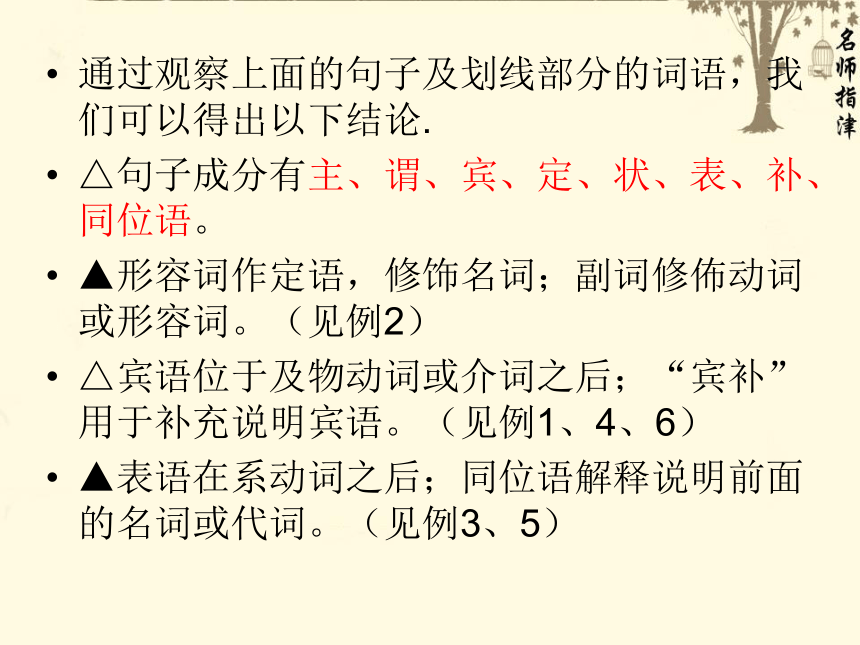

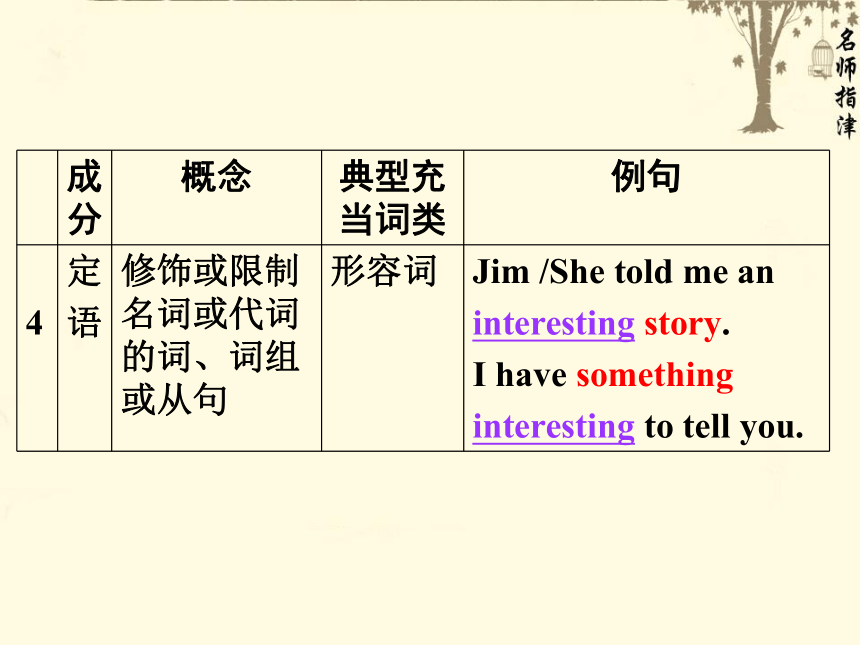
文档简介
(共22张PPT)
十
大
词
类
词类
概念或作用
例词
主要句法作用
实
词
名词
(n.)
表示人或事物名称的词
desk,
book
主、宾、表
代词
(pron.)
用来代替名词或名词短语的词
you,
me,
his
主、宾、表、定
动词
(v.)
表示动作或状态的词或短语
read,
write
谓语
词类
概念或作用
例词
主要句
法作用
实
词
形容词
(adj.)
修饰名词,说明人或事物是什么样的
beautiful
定、表、补
副词
(adv.)
修饰动词、形容词、副词、全句,说明时间、地点、方式、程度等
here,
there,
then,
soon
状语、表语(仅限here,
there,
up等)
数词
(num.)
表示数量或顺序
three,
third
主、宾、定、表
词类
概念或作用
例词
主要句
法作用
虚
词
冠词(art.)
在名词前辅助说明名词含义的词
a,
an,
the
不能单独作句子成分,因此叫虚词
介词(prep.)
在名词、代词、动名词等前面,说明该词与别的词之间的关系
in,
on,
at,
for,
during
连词(conj.)
连接词与词、短语与短语、句子与句子
and,
but,
or
感叹词(int.)
表示喜悦、惊讶等情感
ah,
oh,
hi
九
种
成
分
1)The
lady
buys
vegetables.
2)The
old
lady
often
buys
fresh
vegetables.
3)The
old
lady
is
healthy.She
buys
fresh
vegetables
in
the
supermarket
every
day.
4)The
old
lady
buys
us
fresh
vegetables
in
the
supermarket
every
day.
5)The
old
lady,
a
woman
of
sixty,
buys
us
fresh
vegetables
in
the
supermarket
every
day.
6)We
asked
the
lady
to
buy
some
vegetables.
通过观察上面的句子及划线部分的词语,我们可以得出以下结论.
△句子成分有主、谓、宾、定、状、表、补、同位语。
▲形容词作定语,修饰名词;副词修佈动词或形容词。(见例2)
△宾语位于及物动词或介词之后;“宾补”用于补充说明宾语。(见例1、4、6)
▲表语在系动词之后;同位语解释说明前面的名词或代词。(见例3、5)
成分
概念
典型充当词类
例句
1
主语
句子要说明的人或事物
名词、代词
Tom
/He
works
hard.
2
谓语
说明主语的动作或状态,即主语是什么、干什么
动词
My
ambition
is
to
become
a
scientist.
I
love
you.
3
宾语
动词的动作对象或动作的承受者;介词后
名词、代词
Mary
told
me
a
story.
He
goes
to
school
by
bus
every
day.
成分
概念
典型充当词类
例句
4
定
语
修饰或限制名词或代词的词、词组或从句
形容词
Jim
/She
told
me
an
interesting
story.
I
have
something
interesting
to
tell
you.
成分
概念
典型充当词类
例句
5
状
语
修饰动词、形容词、副词或全句,说明地点、时间、原因、目的、结果、条件、方向、程度、方式和伴随状况等
副词
He
can
speak
English
fluently.(修饰动词)
The
suitcase
is
surprisingly
light.(修饰形容词)
I
go
jogging
fairly
regularly.(修饰另一副词)
Surprisingly,
he
agreed
straight
away.(修饰全句)
成分
概念
典型充当词类
例句
6
补语
补充说明宾语或主语
形容词
We’ll
make
our
school
more
beautiful.
The
room
was
found
empty.
7
表语
位于系动词之后且与系动词一起构成谓语,表示主语的性质、状态和特征
形容词
He
is
asleep.
Her
voice
sounds
sweet.
The
match
became
very
exciting.
成分
概念
典型充当词类
例句
8
同位语
具有相同语法地位且描述同一人或事的两个名词或代词(词组)
名词
Mr
Li,
our
English
teacher,
is
kind
to
us.
代词
Helping
others
is
a
habit,
one
you
can
learn.
从句
We
are
glad
at
the
news
that
he
will
come.
成分
概念
典型充当词类
例句
9
插入语
插入句中的独立语,不作句子的何种成分,用于补充说话者的态度、引起听话者的注意,或使前后衔接
短
句
That,
I
think,
would
be
a
great
advantage.
I
can’t
attend
your
lecture,
I’m
afraid.
不定式
To
tell
you
the
truth,
I
hate
to
do
it.
成分
概念
典型充当词类
例句
9
插入语
插入句中的独立语,不作句子的何种成分,用于补充说话者的态度、引起听话者的注意,或使前后衔接
分
词
Generally
speaking,
we
enjoyed
the
trip.
介
词
短
语
In
short,
we
should
stop
halfway.
形容词
Worse
still,
we
got
lost
in
the
dark.
副
词
I
can’t
go.
To
begin
with,
it’s
too
cold.
Besides,
I’ve
no
money.
由上表可以看出:
句子成分与词性的关系,主要有:
1.
作主语或宾语用名词或代词。
2.
作谓语用动词。
4.
作状语用副词(修饰动词、形容词、介词短语或全句)。
3.
作定语(修饰名词)、表语、补语,用形容词
以上四条是解答语法填空的必备基础,请反复朗读表中例句,仔细体会这四条。
简单句
复合句
用途
主语
主语从句
句中作主语
宾语
宾语从句
句中作宾语
定语
定语从句
句中作定语
状语
状语从句
句中作状语
表语
表语从句
句中作表语
同位语
同位语从句
句中作同位语
谓语
时态和语态
句子核心
谓语
非谓语动词
构成短语
通过这个图表,我们可以知道学习句子成分的作用。
我们为什么要学句子成分?
三点建议:
1.
在学习和理解句子时,可以将take
care
of
(照顾),
have
a
discussion
of(讨论),
get
some
knowledge
of(了解)等短语动词看作一个整体,相当于一个及物动词;将a
wide
variety
of
(多种多样的),
all
kinds
of(各种各样的)等当作一个整体,相当于短语形容词,在名词前作定语。
2.
我们在阅读中要善于抓住句子的主干,即主谓宾,先理解主干,再理解句子的次要成分,这是理解长难句的基础。
3.
划分句子的目的是为了理解或写出正确
的句子,但如果你一看就知道句子的大意了,那就不必再去考究某个部分到底是作
什么句子成分了,以免本末倒置;一旦某
个或某些地道的英语句子背熟了,你只需
仿照这些句子去说去写就行了,也不必考究,到底为什么是这样,某个部分是什么
句子成分,使自己陷入学习的怪圈,也害
苦自己。
请指出下列各句的句子成分,定语直接用
(
)括起来。
1.
We
learned
them
at
a
young
age.
We
(主语)
learned
(谓语)
them
(宾语)
at
a
young
age(状语).
2.
I
will
help
you
read
and
understand
the
selected
poems.
I
(主语)
will
help
(谓语)
you
(宾语)
read
and
understand
the
selected
poems(宾补).
3.
The
museum
is
on
the
Yellow
River
Road.
The
museum
(主语)
is
(系动词)
on
the
Yellow
River
Road(表语).
4.
We
can
meet
at
the
bus
stop
outside
the
school
gate
at
9
am.
We
(主语)
can
meet
(谓语)
at
the
bus
stop
outside
the
school
gate
(地点状语)
at
9
am
(时
间状语).
5.
The
Chinese
paper-cutting
art
exhibition
offers
us
a
wide
variety
of
traditional
and
modern
Chinese
paper-cutting)
works
by
famous
local
folk
artists.
(The
Chinese
paper-cutting
art)
exhibition
(主
语)
offers
(谓语)
us
(间接宾语)
(a
wide
variety
of
traditional
and
modern
Chinese
paper-cutting)
works
(直接宾语)
(by
famous
local
folk
artists).
Thank
you
!
十
大
词
类
词类
概念或作用
例词
主要句法作用
实
词
名词
(n.)
表示人或事物名称的词
desk,
book
主、宾、表
代词
(pron.)
用来代替名词或名词短语的词
you,
me,
his
主、宾、表、定
动词
(v.)
表示动作或状态的词或短语
read,
write
谓语
词类
概念或作用
例词
主要句
法作用
实
词
形容词
(adj.)
修饰名词,说明人或事物是什么样的
beautiful
定、表、补
副词
(adv.)
修饰动词、形容词、副词、全句,说明时间、地点、方式、程度等
here,
there,
then,
soon
状语、表语(仅限here,
there,
up等)
数词
(num.)
表示数量或顺序
three,
third
主、宾、定、表
词类
概念或作用
例词
主要句
法作用
虚
词
冠词(art.)
在名词前辅助说明名词含义的词
a,
an,
the
不能单独作句子成分,因此叫虚词
介词(prep.)
在名词、代词、动名词等前面,说明该词与别的词之间的关系
in,
on,
at,
for,
during
连词(conj.)
连接词与词、短语与短语、句子与句子
and,
but,
or
感叹词(int.)
表示喜悦、惊讶等情感
ah,
oh,
hi
九
种
成
分
1)The
lady
buys
vegetables.
2)The
old
lady
often
buys
fresh
vegetables.
3)The
old
lady
is
healthy.She
buys
fresh
vegetables
in
the
supermarket
every
day.
4)The
old
lady
buys
us
fresh
vegetables
in
the
supermarket
every
day.
5)The
old
lady,
a
woman
of
sixty,
buys
us
fresh
vegetables
in
the
supermarket
every
day.
6)We
asked
the
lady
to
buy
some
vegetables.
通过观察上面的句子及划线部分的词语,我们可以得出以下结论.
△句子成分有主、谓、宾、定、状、表、补、同位语。
▲形容词作定语,修饰名词;副词修佈动词或形容词。(见例2)
△宾语位于及物动词或介词之后;“宾补”用于补充说明宾语。(见例1、4、6)
▲表语在系动词之后;同位语解释说明前面的名词或代词。(见例3、5)
成分
概念
典型充当词类
例句
1
主语
句子要说明的人或事物
名词、代词
Tom
/He
works
hard.
2
谓语
说明主语的动作或状态,即主语是什么、干什么
动词
My
ambition
is
to
become
a
scientist.
I
love
you.
3
宾语
动词的动作对象或动作的承受者;介词后
名词、代词
Mary
told
me
a
story.
He
goes
to
school
by
bus
every
day.
成分
概念
典型充当词类
例句
4
定
语
修饰或限制名词或代词的词、词组或从句
形容词
Jim
/She
told
me
an
interesting
story.
I
have
something
interesting
to
tell
you.
成分
概念
典型充当词类
例句
5
状
语
修饰动词、形容词、副词或全句,说明地点、时间、原因、目的、结果、条件、方向、程度、方式和伴随状况等
副词
He
can
speak
English
fluently.(修饰动词)
The
suitcase
is
surprisingly
light.(修饰形容词)
I
go
jogging
fairly
regularly.(修饰另一副词)
Surprisingly,
he
agreed
straight
away.(修饰全句)
成分
概念
典型充当词类
例句
6
补语
补充说明宾语或主语
形容词
We’ll
make
our
school
more
beautiful.
The
room
was
found
empty.
7
表语
位于系动词之后且与系动词一起构成谓语,表示主语的性质、状态和特征
形容词
He
is
asleep.
Her
voice
sounds
sweet.
The
match
became
very
exciting.
成分
概念
典型充当词类
例句
8
同位语
具有相同语法地位且描述同一人或事的两个名词或代词(词组)
名词
Mr
Li,
our
English
teacher,
is
kind
to
us.
代词
Helping
others
is
a
habit,
one
you
can
learn.
从句
We
are
glad
at
the
news
that
he
will
come.
成分
概念
典型充当词类
例句
9
插入语
插入句中的独立语,不作句子的何种成分,用于补充说话者的态度、引起听话者的注意,或使前后衔接
短
句
That,
I
think,
would
be
a
great
advantage.
I
can’t
attend
your
lecture,
I’m
afraid.
不定式
To
tell
you
the
truth,
I
hate
to
do
it.
成分
概念
典型充当词类
例句
9
插入语
插入句中的独立语,不作句子的何种成分,用于补充说话者的态度、引起听话者的注意,或使前后衔接
分
词
Generally
speaking,
we
enjoyed
the
trip.
介
词
短
语
In
short,
we
should
stop
halfway.
形容词
Worse
still,
we
got
lost
in
the
dark.
副
词
I
can’t
go.
To
begin
with,
it’s
too
cold.
Besides,
I’ve
no
money.
由上表可以看出:
句子成分与词性的关系,主要有:
1.
作主语或宾语用名词或代词。
2.
作谓语用动词。
4.
作状语用副词(修饰动词、形容词、介词短语或全句)。
3.
作定语(修饰名词)、表语、补语,用形容词
以上四条是解答语法填空的必备基础,请反复朗读表中例句,仔细体会这四条。
简单句
复合句
用途
主语
主语从句
句中作主语
宾语
宾语从句
句中作宾语
定语
定语从句
句中作定语
状语
状语从句
句中作状语
表语
表语从句
句中作表语
同位语
同位语从句
句中作同位语
谓语
时态和语态
句子核心
谓语
非谓语动词
构成短语
通过这个图表,我们可以知道学习句子成分的作用。
我们为什么要学句子成分?
三点建议:
1.
在学习和理解句子时,可以将take
care
of
(照顾),
have
a
discussion
of(讨论),
get
some
knowledge
of(了解)等短语动词看作一个整体,相当于一个及物动词;将a
wide
variety
of
(多种多样的),
all
kinds
of(各种各样的)等当作一个整体,相当于短语形容词,在名词前作定语。
2.
我们在阅读中要善于抓住句子的主干,即主谓宾,先理解主干,再理解句子的次要成分,这是理解长难句的基础。
3.
划分句子的目的是为了理解或写出正确
的句子,但如果你一看就知道句子的大意了,那就不必再去考究某个部分到底是作
什么句子成分了,以免本末倒置;一旦某
个或某些地道的英语句子背熟了,你只需
仿照这些句子去说去写就行了,也不必考究,到底为什么是这样,某个部分是什么
句子成分,使自己陷入学习的怪圈,也害
苦自己。
请指出下列各句的句子成分,定语直接用
(
)括起来。
1.
We
learned
them
at
a
young
age.
We
(主语)
learned
(谓语)
them
(宾语)
at
a
young
age(状语).
2.
I
will
help
you
read
and
understand
the
selected
poems.
I
(主语)
will
help
(谓语)
you
(宾语)
read
and
understand
the
selected
poems(宾补).
3.
The
museum
is
on
the
Yellow
River
Road.
The
museum
(主语)
is
(系动词)
on
the
Yellow
River
Road(表语).
4.
We
can
meet
at
the
bus
stop
outside
the
school
gate
at
9
am.
We
(主语)
can
meet
(谓语)
at
the
bus
stop
outside
the
school
gate
(地点状语)
at
9
am
(时
间状语).
5.
The
Chinese
paper-cutting
art
exhibition
offers
us
a
wide
variety
of
traditional
and
modern
Chinese
paper-cutting)
works
by
famous
local
folk
artists.
(The
Chinese
paper-cutting
art)
exhibition
(主
语)
offers
(谓语)
us
(间接宾语)
(a
wide
variety
of
traditional
and
modern
Chinese
paper-cutting)
works
(直接宾语)
(by
famous
local
folk
artists).
Thank
you
!
